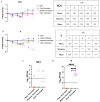Vaccination against SARS-CoV-2 Does Not Protect against the Development of Anosmia in a Hamster Model
- PMID: 37896967
- PMCID: PMC10611162
- DOI: 10.3390/vaccines11101564
Vaccination against SARS-CoV-2 Does Not Protect against the Development of Anosmia in a Hamster Model
Abstract
Anosmia, a total or partial loss of the ability to smell, is one of the most frequently documented sequelae of severe acute respiratory syndrome coronavirus-2 (SARS-CoV-2) infection. Persistent anosmia is associated with a decrease in quality of life. Here, we assess the impact of virus lineage and vaccination status on anosmia development in the golden Syrian hamster model. To characterize anosmia driven by current variants, we assessed olfactory function in hamsters infected with SARS-CoV-2 lineages A, BA.2, BA.5, BQ.1, and BQ.1.1 using a buried food detection test. We found that significant anosmia occurs upon infection with all variants with a significant correlation between disease severity and degree of anosmia. Moreover, we found that vaccination with either the Pfizer (BNT16b2) or Moderna (mRNA-1273) mRNA vaccines does not protect against anosmia, despite protection against severe disease.
Keywords: SARS-CoV-2; anosmia; sequelae; vaccination.
Conflict of interest statement
The authors declare no conflict of interest.
Figures



Similar articles
-
Recovery of anosmia in hamsters infected with SARS-CoV-2 is correlated with repair of the olfactory epithelium.Sci Rep. 2022 Jan 12;12(1):628. doi: 10.1038/s41598-021-04622-9. Sci Rep. 2022. PMID: 35022504 Free PMC article.
-
A Heterologous Challenge Rescues the Attenuated Immunogenicity of SARS-CoV-2 Omicron BA.1 Variant in Syrian Hamster Model.J Virol. 2023 Feb 28;97(2):e0168422. doi: 10.1128/jvi.01684-22. Epub 2023 Jan 18. J Virol. 2023. PMID: 36651747 Free PMC article.
-
Characterization of the SARS-CoV-2 BA.5.5 and BQ.1.1 Omicron Variants in Mice and Hamsters.bioRxiv [Preprint]. 2023 May 1:2023.04.28.538747. doi: 10.1101/2023.04.28.538747. bioRxiv. 2023. Update in: J Virol. 2023 Sep 28;97(9):e0062823. doi: 10.1128/jvi.00628-23. PMID: 37205409 Free PMC article. Updated. Preprint.
-
COVID-19 vaccines: comparison of biological, pharmacological characteristics and adverse effects of Pfizer/BioNTech and Moderna Vaccines.Eur Rev Med Pharmacol Sci. 2021 Feb;25(3):1663-1669. doi: 10.26355/eurrev_202102_24877. Eur Rev Med Pharmacol Sci. 2021. PMID: 33629336 Review.
-
Objective Sensory Testing Methods Reveal a Higher Prevalence of Olfactory Loss in COVID-19-Positive Patients Compared to Subjective Methods: A Systematic Review and Meta-Analysis.Chem Senses. 2020 Dec 5;45(9):865-874. doi: 10.1093/chemse/bjaa064. Chem Senses. 2020. PMID: 33245136 Free PMC article.
Cited by
-
Histopathology of the Tongue in a Hamster Model of COVID-19.Res Sq [Preprint]. 2024 Jul 4:rs.3.rs-4590482. doi: 10.21203/rs.3.rs-4590482/v1. Res Sq. 2024. Update in: BMC Oral Health. 2025 Jan 23;25(1):121. doi: 10.1186/s12903-025-05420-9. PMID: 39011098 Free PMC article. Updated. Preprint.
-
Optimization of a panel of behavioral tests for use in containment using a golden Syrian hamster model.J Virol Methods. 2025 Jun;335:115132. doi: 10.1016/j.jviromet.2025.115132. Epub 2025 Mar 3. J Virol Methods. 2025. PMID: 40043811 Free PMC article.
-
Histopathology of the tongue in a hamster model of COVID-19.BMC Oral Health. 2025 Jan 23;25(1):121. doi: 10.1186/s12903-025-05420-9. BMC Oral Health. 2025. PMID: 39849469 Free PMC article.
-
SARS-CoV-2-induced sensory perturbations: A narrative review of clinical phenotypes, molecular pathologies, and possible interventions.Brain Behav Immun Health. 2025 Mar 24;45:100983. doi: 10.1016/j.bbih.2025.100983. eCollection 2025 May. Brain Behav Immun Health. 2025. PMID: 40231214 Free PMC article. Review.
References
-
- Center for Systems Science and Engineering (CSSE) at Johns Hopkins University (JHU) COVID-19 Dashboard. [(accessed on 14 March 2023)]. Available online: https://coronavirus.jhu.edu/map.html.
-
- Lechien J.R., Chiesa-Estomba C.M., De Siati D.R., Horoi M., Le Bon S.D., Rodriguez A., Dequanter D., Blecic S., El Afia F., Distinguin L., et al. Olfactory and gustatory dysfunctions as a clinical presentation of mild-to-moderate forms of the coronavirus disease (COVID-19): A multicenter European study. Eur. Arch. Otorhinolaryngol. 2020;277:2251–2261. doi: 10.1007/s00405-020-05965-1. - DOI - PMC - PubMed
Grants and funding
LinkOut - more resources
Full Text Sources
Miscellaneous

